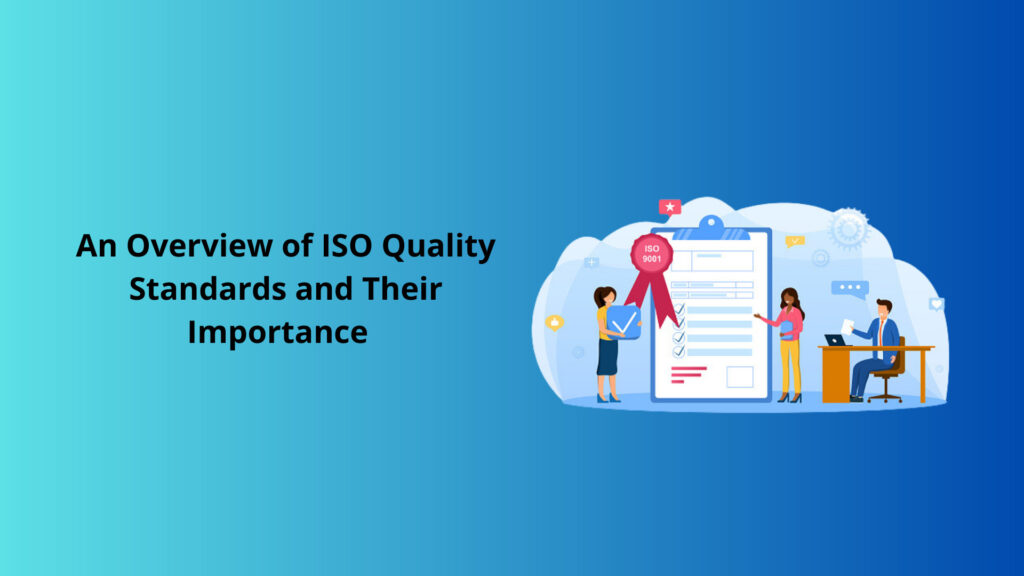Achieving success depends critically on assuring the calibre and consistency of goods and services. Organisations can do this by following ISO quality standards, for example. The ISO 9001 Certification stands out as a pillar for quality management among these. This article will explore the importance of ISO Quality Standards, emphasising ISO 9001 certification. Let’s investigate how these guidelines help to improve business operations and client happiness.
What is ISO Quality Standards
The International Organisation for Standardisation (ISO) is a private, non-governmental organisation that creates and disseminates standards to guarantee the effectiveness, efficiency, and quality of goods, services, and systems. The ISO quality standards offer a widely accepted framework for businesses to create and implement efficient quality management systems.
Understanding ISO 9001 Certification
The most widely used and recognised quality management standard globally is ISO 9001. It indicates the requirements for a quality management system businesses may use to improve operations and reliably satisfy consumer expectations. When an organisation receives ISO 9001 certification, it has successfully satisfied the standards established by the organisation, proving its dedication to high standards of quality, ongoing improvement, and client satisfaction.
Benefits of Implementing ISO Quality Standards
Here we can explore the benefits of implementing ISO quality standards:
Enhanced Customer Satisfaction
Customer satisfaction is a key component of ISO 9001 Certification. Organisations may produce goods and services that appeal to their target market by building procedures that prioritise satisfying client wants and expectations. Generating favourable word-of-mouth recommendations results in improved customer retention rates and helps businesses draw in new clients.
Streamlined Processes
Organisations are encouraged by ISO Quality Standards to simplify their operations, get rid of waste, and make the most use of their resources. This emphasis on efficiency frequently leads to lower operating expenses and higher production. Clear processes and clearly defined roles also facilitate smoother operations and speedier decision-making.
Data-Driven Decision Making
The necessity of data-driven decision-making is emphasised by ISO 9001. Organisations must gather and analyse pertinent data to pinpoint improvement opportunities and monitor key performance indicators. Thanks to this data-driven strategy, organisations are empowered to take well-informed decisions that enhance their overall success.
Implementing ISO Quality Standards: Key Steps
Let’s read about some key steps of implementing ISO quality standards:
Gap Analysis
Organisations frequently do a gap analysis before obtaining ISO 9001 certification. This entails contrasting their current quality management procedures with the ISO standards. The implementation process gets underway with the gaps that have been found.
Process Documentation
One of the most important steps in adhering to ISO standards is documenting processes and procedures. Employee understanding of duties and responsibilities is ensured through clear documentation, which also serves as a point of reference for consistent implementation.
Training and Awareness
The adoption of ISO is successful in large part because of the employees. It is easier to ensure everyone is on the same page and dedicated to adhering to the defined procedures by offering training and raising awareness about the ISO 9001 standard.
Continuous Improvement
Continuous improvement is the cornerstone upon which ISO 9001 is founded. Organisations are urged to evaluate their procedures frequently, get input, and make adjustments that result in small improvements.
ISO Quality Standards: A Multifaceted Approach to Excellence
Beyond ISO 9001 certification, a wide range of topics are covered by ISO quality standards. These standards cover various topics, including information security (ISO 27001) and environmental management (ISO 14001). To maintain compliance and achieve excellence in their respective professions, organisations must fulfil certain standards that are the emphasis of each standard.
ISO 14001: Nurturing Environmental Responsibility
Environmental management is the focus of ISO 14001. This standard guides organisations to implement efficient waste minimisation, waste reduction, and sustainable operations systems. The achievement of ISO 14001 certification shows a company’s dedication to environmental stewardship and advances the cause of a greener future.
ISO 27001: Safeguarding Information Assets
Information security is crucial at a time of digital transition. An information security management system may be created, implemented, maintained, and constantly improved using the framework provided by ISO 27001. Organisations may reassure their stakeholders that their priceless information assets are protected from cyber threats and breaches by acquiring ISO 27001 certification.
ISO 45001: Prioritising Occupational Health and Safety
One of the pillars of successful organisations is employee well-being. The foundation for occupational health and safety management systems is laid by ISO 45001. By upholding this guideline, businesses may make their workplaces safer, lower the number of accidents, and improve their staff’s physical and mental health. ISO 45001 accreditation demonstrates a company’s commitment to promoting a safety culture.
ISO 20000-1: Elevating IT Service Management
Effective IT service management is crucial in the digital era. ISO 20000-1 offers instructions for setting up an IT service management system that ties IT services to corporate goals. This standard aids businesses in ensuring smooth service delivery, quick problem-solving, and higher levels of client satisfaction. The ISO 20000-1 certification demonstrates a company’s dedication to providing first-rate IT services.
ISO 50001: Driving Energy Efficiency
The ISO 50001 standard responds to the rising environmental concerns over energy use. This standard is centred on energy management systems, helping businesses increase their energy effectiveness, lower energy costs, and advance sustainability objectives. A company’s commitment to resource conservation and reducing its carbon impact is demonstrated by obtaining ISO 50001 accreditation.
Implementing ISO Standards: Rewards and Challenges
Although applying ISO standards has many advantages, the process is challenging. Resource limitations, opposition to change, and the difficulty of aligning current procedures with ISO standards are common challenges for organisations. The benefits, however, considerably exceed the difficulties.
- By putting ISO standards into practice, an organisation-wide quality culture is promoted. Employees are more aware of their responsibilities in providing high-quality goods and services.
- In a cutthroat industry, ISO certification sets organisations distinct. It demonstrates a dedication to quality and appeals to clients looking for dependable and trustworthy partners. Organisations with ISO certification are frequently the first options for contracts and cooperation.
- A learning experience is a path to ISO certification. Organisations examine their procedures in-depth, pinpointing areas for improvement. Beyond certification, this culture of continual improvement supports sustained success.
Conclusion
An illustration of how the ISO quality standards could offer firms a road to excellence is the ISO 9001 certification. By following these guidelines, businesses may develop solid quality management systems that support client satisfaction, operational effectiveness, and continual improvement. Adopting ISO standards is a strategic need for firms looking to thrive in a cutthroat environment as the corporate world evolves.




